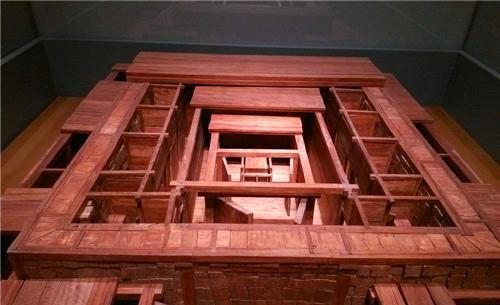Whether it is now or in the past, many people have always had the idea that there will still be another world after death, so ancient emperors will be buried with a large amount of gold and silver treasures and other luxury goods when they are buried. Many people also set their sights on these tombs, hoping to earn their own ill-gotten gains, so tomb robbers were born.
And the tomb robbers robbed the emperor's tomb, but they were most afraid of encountering something called "yellow intestine inscription", why is this?

First of all, let's take a look at what is called "yellow intestine problem". "Tijia" is a burial chamber style, derived from the Zhou Dynasty and Han Dynasty, and the Han Dynasty has rarely been used since the Han Dynasty, and the yellow intestine, according to the ancient scholar Su Lin, is a yellow cypress, that is, a peeled cypress tree. Because most of the wood used for the inscription is cypress rafters that take the bark, it is named after it.
The yellow intestine inscription "One was first seen in the Book of Han and the Biography of Huo Guang" (汉書· According to the book, when Tianzi was buried, he used cypress wood to form a coffin shape, and there was a toilet room outside, and it was also made of cypress wood, which contained a large number of funerary items. Book of the Later Han Dynasty: "When the mausoleum was built, Fang Shizhi yellow intestines were inscribed with a toilet room as a ceremony. ”
In today's archaeology, a number of yellow intestine stone tombs have been found, a tomb of the Eastern Han Princes in Dingxian County, Hebei Province, there are more than 4,000 pieces of yellow intestine stone, most of which are chiseled nearly square, and the tomb robbers are the most reluctant to see this yellow intestine inscription, they prefer stone tombs, brick tombs, this is because with the age of time, stone bricks will slowly wind erosion, but cypress wood is an extremely corrosion-resistant and hard tree, although the yellow intestine inscription is only a rafter, but compared to stone buildings , but much taller.
And the tomb robbers with shovels and other objects, is not able to pry open the door of the rafters, many tomb robbers are because they do not have the right tools in their hands, and the eyes of this kind of rafters are dry, but although this chamber is very strong, but such a finely crafted yellow intestine also takes a lot of time.
Qin Jinggong in the Spring and Autumn Period and the Warring States Period used this kind of tomb, the "yellow intestine" he used came from the wooden core of the cypress tree, and the tomb of Qin Jinggong was surrounded by a square, a beam weighed three hundred kilograms, these woods were neatly stacked around the coffin, becoming an unbreakable wall, which is why it is so difficult to steal the tomb.
At the same time, the archaeological team is also very careful about this structural style, so experts will also say that the yellow intestine is best not to touch, but to use professional tools to empty the surrounding land for excavation, because the destruction of the structure of the problem is likely to lead to the collapse of the entire tomb.
Cao Cao was a famous tomb robber ancestor, who had organized the gold lieutenants under his hands to steal the tomb many times, but Cao Cao was afraid that his tomb would be stolen, so he ordered the abolition of the custom of thick burial in the whole country and changed it to thin burial, and at the same time, the burial chamber of the yellow intestine inscription was gradually eliminated.
However, the characteristics of the inscription have helped historians a lot, because of its super difficult to develop characteristics, resulting in many tomb robbers to this coffin are useless, so the tombs of many princes and nobles in the Han Dynasty have been relatively well preserved, and the tombs of Liu Dan, the King of Fengtai Yan in Beijing excavated after the founding of the People's Republic of China, and the tomb of Liu Yan, the King of Zhongshan jian in Dingxian County, Hebei Province, are all of this style.
Even in modern times, archaeological work, with sophisticated instruments, is very difficult to mine these tombs, let alone tomb robbers, so the "yellow intestine inscription" has become one of the things that Lieutenant Touching Gold hates the most.